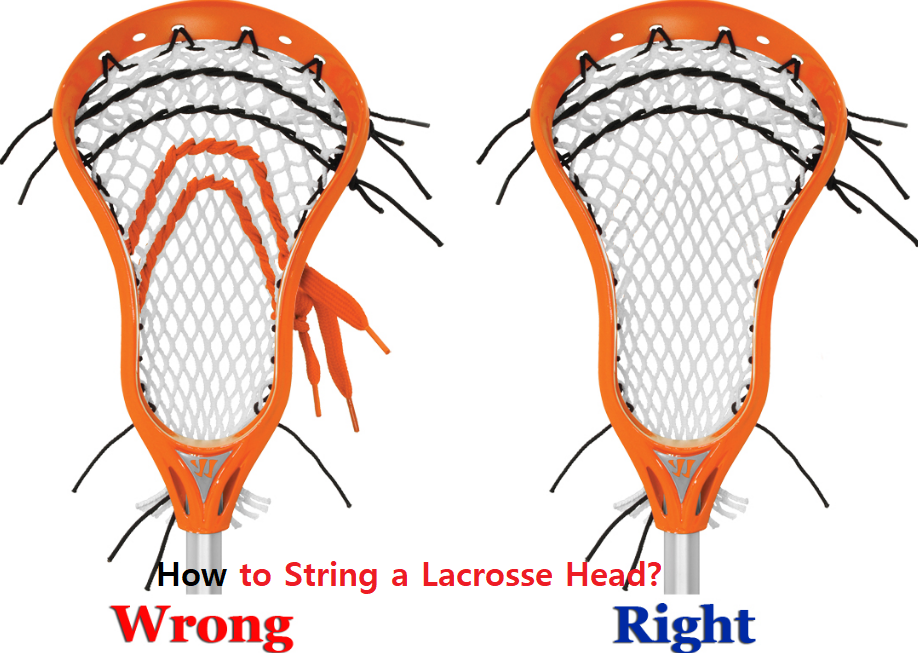How to String a Lacrosse Head? Stringing your own lacrosse head can be a tough task for new lacrosse players. But with these stringing directions, plus a little bit of practice, you’ll be able to get your pocket the way you like it.

Table of Contents
WHAT YOU NEED
Before you get begun, make sure you have all the items needed to string a lacrosse head:
- Unstrung Head
- Mesh
- Strings
- Scissors
- Lighter
- Pliers
MESH
Once you have all your gear, the initial step to stringing a lacrosse head is making sure the mesh is ready to go. Here’s how:
- Take your mesh and place the top, bottom, front, and back. The top will have nine diamonds across the edge. The bottom will have 10 diamonds. The front side will feel more intimidating; this is the side that makes contact with the ball.
- Stretch the mesh out to get it performed in and ready to string.
- Bring the top nine-diamond row and fold it onto the nine-diamond row below it. You should be able to walk through these diamonds when done correctly.
After you have the mesh prepared, you can begin the process of stringing the top of the mesh into the head. Function from left to right as you tie knots to keep the mesh in place. Maintain constant tension throughout the process. When you’re finished, the center of the mesh should line up with the center of the head.
SIDEWALLS
Once you have the top string installed, you’re ready to tackle the sidewalls. This process can influence the kind of pocket placement you have. There are several ways to string a lacrosse head, but Greg Kenneally, president, and co-founder of East Coast Dyes suggests a mid-pocket setup. This type of pocket has a solid hold and a smooth release and can be a solid option for new players.
- It is best to have a pair of diamonds pulled down tightly in the head as soon as possible. This will make a flat area near the top, which is referred to as the channel and will help the ball release down the middle. You can make the pocket looser at the bottom by bunching the diamonds.
- Remember there is a legal limit to the depth of your pocket. If you put a ball into the pocket, you should not be able to catch any air above the ball.
- Complete by installing the bottom string and the last row of diamonds. With this phase, if your pocket is too deep, you can pull your pocket tighter.
The following step is to install the shooting strings. Remember that all shooting strings must be within the top four inches of the head measured from the top of the scoop. Weave the shooting string lightly through the mesh. The string closest to the ball should be the most flexible. As you work your path up to the scoop, the shooting strings should become tighter.
Many lacrosse string kits come with different strings so lacrosse players can use different techniques when stringing their heads. Because of this, you could end up with several inches of additional string. Cut that down to two inches or less with enough left to tighten the strings if needed. Then carefully melt the ends of the string with a more delicate to help prevent fraying.
Stringing a lacrosse head is a skill multiple lacrosse players want to master. Follow these steps and you’ll be well on your path to crafting the perfect pocket.
FAQs
Knowing how to string ahead is a skill that can help lacrosse players personalize their sticks. Stringing your own lacrosse head can be a tough task for new lacrosse players. But with these stringing tips, plus a little bit of practice, you’ll be able to get your pocket the way you like it.
Assuming you’re a beginner who hasn’t got a clue about how to string a lacrosse head we’d estimate that you’ll be able to finish the task in 30-45 minutes once you’ve followed all the steps in this guide.
The average cost to restring a lacrosse head in the United States without stringing supplies can vary between $10 – $25 dollars depending on the stringer.
